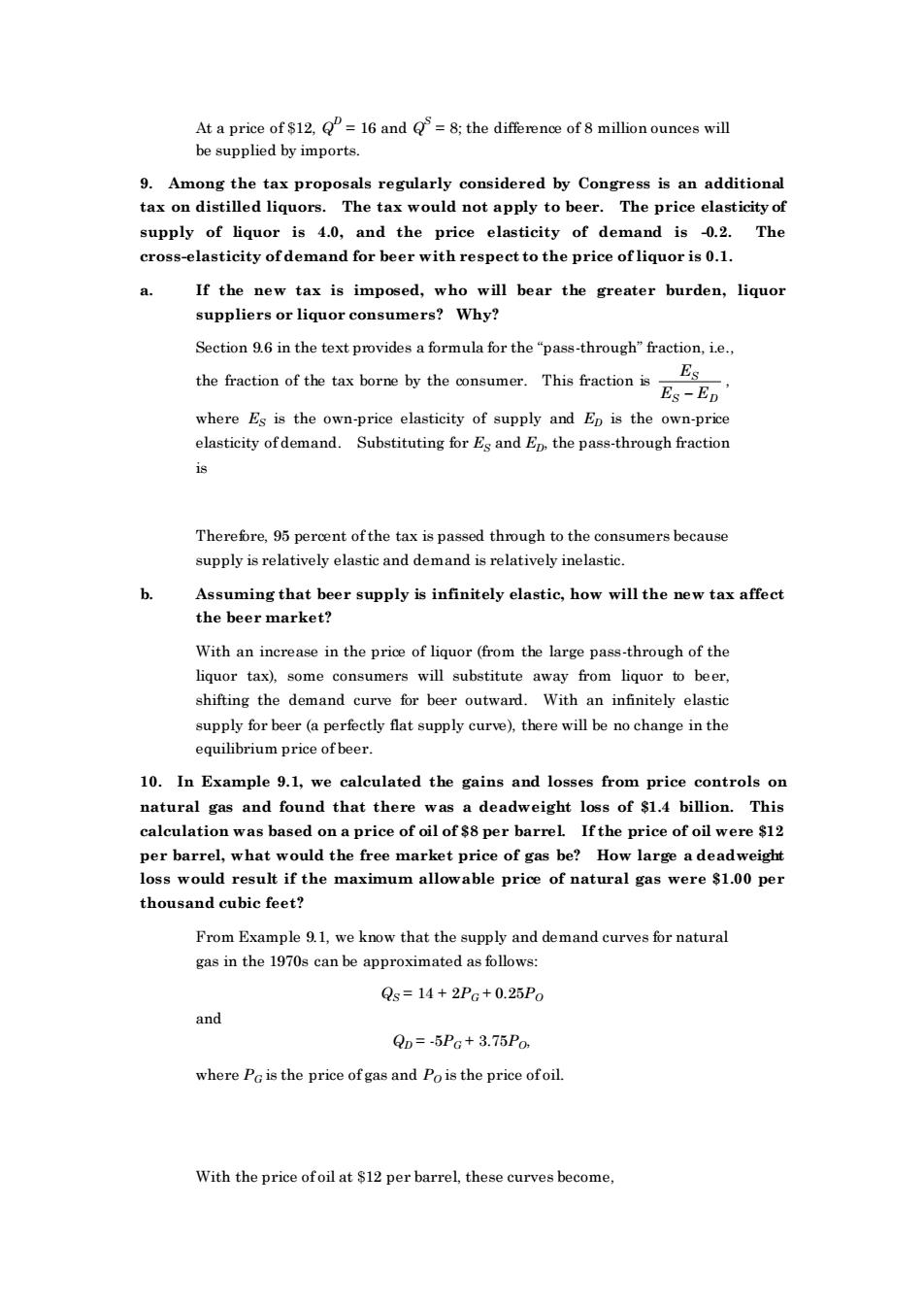正在加载图片...

At a price andthe be supplied by imports. 9.Among the tax proposals regularly considered by Congress is an additional tax on distilled liquors.The tax would not apply to beer.The price elasticityof supply of liquor is 4.0,and the price elasticity of demand is 0.2. The cross-elasticity ofdemand for beer with respect to the price of liquor is 0.1. If the new tax is imposed,who will bear the greater burden,liquor suppliers or liquor consumers?Why? Section 96 in the text provides a formula for the"pass-through"fraction,i.e. Ep' where Es is the own-price elasticity of supply and Ep is the own-price elasticity ofdemand.Substituting for Es and En the pass-through fraction s Therere perent of the tax is pa assed through to the consumers because supply is relatively elastic and demand is relatively inelasti Ass er supply is infinitely elastic,how will the new tax affect With an increase in the price of liquor (from the large pass-through of the lquor tax),some consumers will substitute away from liquor to beer shifting the demand curve for beer outward.With an infinitely elastic (up)b no change in the equilibrium price of beer. 10.In Example 9.1,we calculated the gains and losses from price controls natural gas and found that there was a deadweight loss of S1.4 billion.Thi calculation was based on a price of oil of $8 per barrel.If the price of oil were $12 per barrel,what would the free market price of gas be?How large a deadweight loss would result if the maximum allowable price of natural gas were $1.00 per thousand cubic feet? From Example 1.we know that the supply and demand curves for natural gas in the 1970s can be approximated as follows Qs=14+2Pc+0.25P and Qp=-5PG+3.75Po where Pcis the price of gas and Pois the price ofoil. With the price ofoil at $12 per barrel these curves become,At a price of $12, Q D = 16 and Q S = 8; the difference of 8 million ounces will be supplied by imports. 9. Among the tax proposals regularly considered by Congress is an additional tax on distilled liquors. The tax would not apply to beer. The price elasticity of supply of liquor is 4.0, and the price elasticity of demand is -0.2. The cross-elasticity of demand for beer with respect to the price of liquor is 0.1. a. If the new tax is imposed, who will bear the greater burden, liquor suppliers or liquor consumers? Why? Section 9.6 in the text provides a formula for the “pass-through” fraction, i.e., the fraction of the tax borne by the consumer. This fraction is E E E S S − D , where ES is the own-price elasticity of supply and ED is the own-price elasticity of demand. Substituting for ES and ED, the pass-through fraction is Therefore, 95 percent of the tax is passed through to the consumers because supply is relatively elastic and demand is relatively inelastic. b. Assuming that beer supply is infinitely elastic, how will the new tax affect the beer market? With an increase in the price of liquor (from the large pass-through of the liquor tax), some consumers will substitute away from liquor to beer, shifting the demand curve for beer outward. With an infinitely elastic supply for beer (a perfectly flat supply curve), there will be no change in the equilibrium price of beer. 10. In Example 9.1, we calculated the gains and losses from price controls on natural gas and found that there was a deadweight loss of $1.4 billion. This calculation was based on a price of oil of $8 per barrel. If the price of oil were $12 per barrel, what would the free market price of gas be? How large a deadweight loss would result if the maximum allowable price of natural gas were $1.00 per thousand cubic feet? From Example 9.1, we know that the supply and demand curves for natural gas in the 1970s can be approximated as follows: QS = 14 + 2PG + 0.25PO and QD = -5PG + 3.75PO, where PG is the price of gas and PO is the price of oil. With the price of oil at $12 per barrel, these curves become